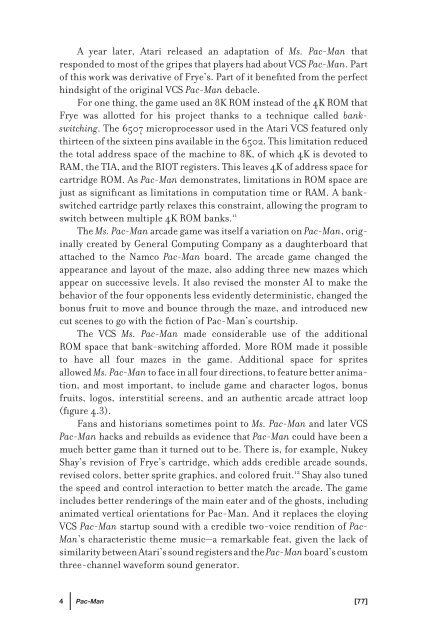Racing the Beam : the Atari Video Computer System - Index of
Racing the Beam : the Atari Video Computer System - Index of
Racing the Beam : the Atari Video Computer System - Index of
You also want an ePaper? Increase the reach of your titles
YUMPU automatically turns print PDFs into web optimized ePapers that Google loves.
A year later, <strong>Atari</strong> released an adaptation <strong>of</strong> Ms. Pac-Man that<br />
responded to most <strong>of</strong> <strong>the</strong> gripes that players had about VCS Pac-Man. Part<br />
<strong>of</strong> this work was derivative <strong>of</strong> Frye’s. Part <strong>of</strong> it benefi ted from <strong>the</strong> perfect<br />
hindsight <strong>of</strong> <strong>the</strong> original VCS Pac-Man debacle.<br />
For one thing, <strong>the</strong> game used an 8K ROM instead <strong>of</strong> <strong>the</strong> 4K ROM that<br />
Frye was allotted for his project thanks to a technique called bankswitching.<br />
The 6507 microprocessor used in <strong>the</strong> <strong>Atari</strong> VCS featured only<br />
thirteen <strong>of</strong> <strong>the</strong> sixteen pins available in <strong>the</strong> 6502. This limitation reduced<br />
<strong>the</strong> total address space <strong>of</strong> <strong>the</strong> machine to 8K, <strong>of</strong> which 4K is devoted to<br />
RAM, <strong>the</strong> TIA, and <strong>the</strong> RIOT registers. This leaves 4K <strong>of</strong> address space for<br />
cartridge ROM. As Pac-Man demonstrates, limitations in ROM space are<br />
just as signifi cant as limitations in computation time or RAM. A bankswitched<br />
cartridge partly relaxes this constraint, allowing <strong>the</strong> program to<br />
switch between multiple 4K ROM banks. 11<br />
The Ms. Pac-Man arcade game was itself a variation on Pac-Man, originally<br />
created by General Computing Company as a daughterboard that<br />
attached to <strong>the</strong> Namco Pac-Man board. The arcade game changed <strong>the</strong><br />
appearance and layout <strong>of</strong> <strong>the</strong> maze, also adding three new mazes which<br />
appear on successive levels. It also revised <strong>the</strong> monster AI to make <strong>the</strong><br />
behavior <strong>of</strong> <strong>the</strong> four opponents less evidently deterministic, changed <strong>the</strong><br />
bonus fruit to move and bounce through <strong>the</strong> maze, and introduced new<br />
cut scenes to go with <strong>the</strong> fi ction <strong>of</strong> Pac-Man’s courtship.<br />
The VCS Ms. Pac-Man made considerable use <strong>of</strong> <strong>the</strong> additional<br />
ROM space that bank-switching afforded. More ROM made it possible<br />
to have all four mazes in <strong>the</strong> game. Additional space for sprites<br />
allowed Ms. Pac-Man to face in all four directions, to feature better animation,<br />
and most important, to include game and character logos, bonus<br />
fruits, logos, interstitial screens, and an au<strong>the</strong>ntic arcade attract loop<br />
(fi gure 4.3).<br />
Fans and historians sometimes point to Ms. Pac-Man and later VCS<br />
Pac-Man hacks and rebuilds as evidence that Pac-Man could have been a<br />
much better game than it turned out to be. There is, for example, Nukey<br />
Shay’s revision <strong>of</strong> Frye’s cartridge, which adds credible arcade sounds,<br />
revised colors, better sprite graphics, and colored fruit. 12 Shay also tuned<br />
<strong>the</strong> speed and control interaction to better match <strong>the</strong> arcade. The game<br />
includes better renderings <strong>of</strong> <strong>the</strong> main eater and <strong>of</strong> <strong>the</strong> ghosts, including<br />
animated vertical orientations for Pac-Man. And it replaces <strong>the</strong> cloying<br />
VCS Pac-Man startup sound with a credible two-voice rendition <strong>of</strong> Pac-<br />
Man’s characteristic <strong>the</strong>me music—a remarkable feat, given <strong>the</strong> lack <strong>of</strong><br />
similarity between <strong>Atari</strong>’s sound registers and <strong>the</strong> Pac-Man board’s custom<br />
three-channel waveform sound generator.<br />
4 Pac-Man [77]


